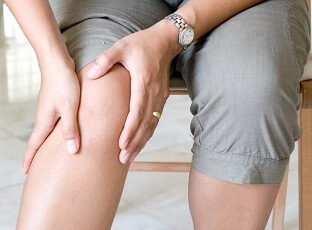- Home
- Knee Joint Anatomy
- Knee Muscles
- Quadriceps
- Rectus Femoris
Rectus Femoris Muscle
Written By: Chloe Wilson, BSc(Hons) Physiotherapy
Reviewed by: KPE Medical Review Board
Rectus Femoris is one of the four quadriceps muscles, found on the front of the thigh, in the centre.
It is the only quadriceps muscle that originates above the hip joint, meaning it produces movement at both the hip and the knee, although its main action is at the knee.
It is a spindle shaped bipennate muscle (i.e. shaped like a feather), meaning it has two rows of muscle fibres that run in opposite diagonal directions from a central tendon, which gives it extra power.
Origin & Insertion
Rectus femoris originates from two places at the pelvis having two heads:

- Straight Head: originates from the anterior inferior iliac spine
- Reflected Head: originates just above the acetabulum (hip socket).
The muscle runs straight down the front of the thigh (rectus is Latin for straight) and about two third of the way down, narrows into a thick tendon which attaches to the upper border of the patella.
Some of the fibres of rectus femoris pass around the kneecap joining with the other quadriceps to form the ligamentum patellae which attaches to the tibia (shin bones) on a bony lump known as the tibial tuberosity, just below the kneecap.
Function Of Rectus Femoris
Rectus femoris can both extend the knee and flex the hip, as it crosses both joints. It works particularly strongly with combined movement of hip flexion and knee extension such as standing up from a seated position, climbing stairs or coming up from a squatting position. It also works hard during a straight leg raise, the lifting up of a straight leg.
When walking, it is particularly active during the swing phase, as the lower leg comes forwards and the knee extends. When standing upright on both legs, there is essentially no action in the quadriceps muscles, but when standing on one leg or on a moving surface, the quadriceps muscles, will work to actively control the leg.
Common Problems
The most common knee problems associate with rectus femoris are:
- Muscle Strain: sudden overloading or over-stretching can cause rectus femoris strain
- Muscle Tightness: tightness in rectus femoris is a common problem, particularly in people who spend much of the day sitting e.g. office workers. This can lead to front knee pain
- Muscle Weakness: Weakness in the quads muscles can affect how the kneecap moves leading to knee cap pain
If you are suffering from knee problems related to rectus femoris, have a look at:
- Quadricep Stretches: Four great stretches for the quadriceps that you can do at home. Includes a simple test to see if your quadriceps are tight so you can see if you would benefit from doing stretches
- Knee Strengthening Exercises: Loads of great exercises to strengthen your quadriceps and other knee muscles. Easy to follow video guides - no specialist equipment needed and they can all be done in your own home
- Knee Muscles: Find out more about the other muscles around the knee
- Knee Pain Diagnosis: Suffering from knee pain but not sure what is going on. Visit the knee diagnosis section for help working out what is causing your pain and learn what you can do to treat it
Summary
Muscle Group: Rectus Femoris forms part of the Quadriceps
Location: Front of the thigh, central
Action: Extends the knee and flexes the hip
Origin: Anterior Inferior Iliac Spine (AIIS) and acetabulum
Insertion: Upper border of patella and patella tendon
Nerve Supply: Muscular branch femoral nerve (L2, L3, L4)
Functional Activities: Getting up from a chair, swing phase of walking
Other Knee Muscles
Page Last Updated: 11/23/21
Next Review Due: 11/23/23






